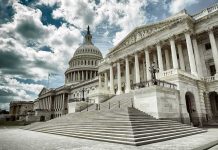
The debate surrounding the Keystone XL pipeline project remains one of the most polarizing aspects of Donald Trump’s energy policy initiatives.
Key Takeaways
- President Trump signed an order clearing obstacles for the pipeline project on his first day in office.
- Trump viewed the pipeline as critical for energy independence and job creation.
- Environmental concerns stemmed from increased carbon emissions risk and potential environmental degradation.
- The Keystone XL faced legal and political setbacks during the Biden administration.
- Alberta Premier Danielle Smith expressed interest in reviving discussions for crude oil export.
Trump’s Energy Push and Symbolism
President Trump wasted no time in his presidency, signing an order on day one to ease federal restrictions on the Keystone XL pipeline. The action had dual implications: it was a nod to his campaign promise of bolstering the nation’s energy infrastructure and creating thousands of jobs. Importing Canadian crude was also part of a broader plan to reduce reliance on foreign oil. Despite these intentions, his stance appeared symbolic amid contentious international trade discussions.
The pipeline’s significance extended beyond economics. Trump’s order immediately countered President Biden’s previous executive decision, blocking the pipeline construction, signaling political determination to reverse certain policies. Yet, Trump’s contradicting trade rhetoric left Canada uncertain, given his threats to impose tariffs on Canadian goods. This approach highlighted complexities in balancing energy policies with diplomatic relations, underscoring a multifaceted strategy by the administration.
The Keystone XL Pipeline has long been at the center of energy policy debates, environmental concerns, and political maneuvering. The controversial project, which aimed to transport crude oil from Canada to U.S. refineries, was canceled by President Joe… pic.twitter.com/gog9aKFlVK
— wahoopredict (@Wahoopredict) January 29, 2025
Environmental Concerns and Political Barriers
Environmental advocacy groups strongly opposed the Keystone XL pipeline, citing potential harm due to increased carbon emissions and environmental degradation risks. Their concerns underscore a broader debate on adopting long-term sustainable environmental practices versus short-term economic gains. During the Biden administration, the project faced numerous legal and political obstacles as executive actions halted construction, reflecting deep divisions over energy policy among lawmakers.
Despite initial enthusiasm, TC Energy Corp., the principal company behind the project formerly known as Trans Canada, ultimately refrained from pursuing the pipeline further. By the time pipeline assets were transferred to South Bow in 2024, interest in reviving plans was practically non-existent. Focus shifted instead to optimizing existing energy infrastructures, albeit with political and public pressures incessantly looming.
Here is a compiled list of major controversies and scandals associated with the Obama administration:
1. **Benghazi Attack (2012)** – Concerns over the handling of the attack on the U.S. consulate in Libya, including the initial response, the security measures, and the… https://t.co/OHD5iSrePN
— Alex Shepard 🇺🇸 (@Sinnersaint39) February 15, 2025
Potential Paths Forward
While South Bow dismissed reviving Keystone XL, potential pathways for crude exports remain subject to political discourse. Alberta Premier Danielle Smith’s willingness to explore new avenues reflects a regional interest in facilitating cross-border energy trade. Their cooperative stance could influence future dialogues related to energy infrastructure. However, any steps toward project revitalization must navigate an intricate landscape of federal regulations and environmental policy considerations.
Alberta’s proactive approach seeks to reconcile environmental concerns with energy sector needs. Pursuing a collaborative framework that addresses both economic and ecological priorities may be crucial in shaping future domestic and international energy strategies.
Sources
1. Trump Says He Wants Keystone XL Pipeline to Be Built
2. Trump Stirs Confusion with Support, Spurning of Canadian Oil









